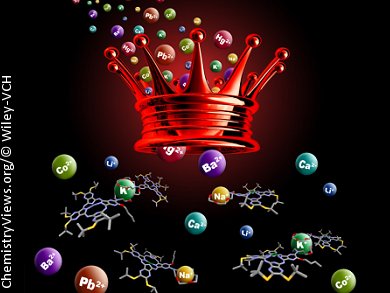Fluorescent indicators are important tools for the analysis of biological cations. The development of probes that absorb and emit red light at wavelengths greater than 630 nm is highly desirable, especially for in vivo applications.
In this context Petr Zimcik and Veronika Novakova from the Charles University, Prague, Poland, have been investigating azaphthalocyanines (AzaPcs), which fluoresce in the red region of the visible spectrum upon binding to metal cations, and as such can be used as sensors.
The concept of sensing metal cations using fluorescence changes in AzaPc molecules that exhibit significant intramolecular charge transfer (ICT) in the OFF state was demonstrated by binding Na+ and K+ to a aza[15]crown-5 recognition moiety. The chelation of these cations switches on strong red fluorescence in AzaPcs, due to an inhibition of ultrafast ICT by coordination of the cations to the donor center. This not only works in organic solvents, but also in water after the sensor molecules are incorporated into silica nanoparticles.
- Azaphthalocyanines: Red Fluorescent Probes for Cations,
V. Novakova, L. Lochman, I. Zajícová, K. Kopecky, M. Miletin, K. Lang, K. Kirakci, P. Zimcik,
Chem. Eur. J. 2013.
DOI: 10.1002/chem.201300079



